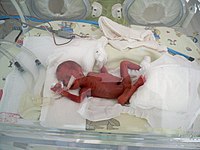
Photo from wikipedia
BACKGROUND Studies investigating the impact of fine particulate matter (PM2.5) exposure during pregnancy upon adverse birth outcomes have primarily been performed in Western nations with low ambient PM2.5 levels. We… Click to show full abstract
BACKGROUND Studies investigating the impact of fine particulate matter (PM2.5) exposure during pregnancy upon adverse birth outcomes have primarily been performed in Western nations with low ambient PM2.5 levels. We examined associations between high levels of PM2.5 exposure during pregnancy and risk of adverse birth outcomes by timing and level of exposure in a Chinese population. METHODS We analysed data from 10,738 live births within the Project ELEFANT study based in Tianjin, China. Personal mean daily PM2.5 exposures were estimated using data from 25 local monitoring sites across the city, used to compute the days exceeding 50, 100, 150, 200 and 250 μg/m3. Relative risk of pre-term birth (<37 weeks) and low birthweight (<2500 g) were estimated by generalised additive distributed lag models, adjusted for maternal age, sex, region, paternal smoking, parity, maternal occupation, season, temperature and dew point. RESULTS A dose-response was exhibited for PM2.5 exposure and relative risk (RR) of adverse birth outcomes, with exposure in the second and third trimesters of pregnancy associated with greatest risk of adverse birth outcomes. The RRs of pre-term birth with exposures of >50, >150 and >250 μg/m3 PM2.5 in the third trimester were 1.09 (95%CI: 1.03-1.16), 1.30 (1.09-1.54) and 2.73 (2.03-3.66) respectively. For low birthweight, exposures of >50, >150 and >250 μg/m3 PM2.5 in the third trimester were associated with RRs of 0.99 (0.88-1.11), 1.37 (1.04-1.81) and 3.03 (1.75-5.23) respectively. CONCLUSIONS Exposure to high levels of PM2.5 from the second trimester onwards were most strongly associated with increased risk of pre-term birth and low birthweight, with a dose-response relationship. Our data demonstrates the need to account for both level and timing of exposure in analysis of PM2.5-associated birth outcomes.
Journal Title: Environmental research
Year Published: 2020
Link to full text (if available)
Share on Social Media: Sign Up to like & get
recommendations!